Make First Aid instructors aware of improved learning outcomes facilitated by the app. Address the hesitation and skepticism that some instructors currently have of the app via a targeted marketing campaign.
Best served user groups
"Captive" audiences
“Captive” audiences consist of a number of critical user groups and individuals requiring First Aid certification to work in their fields and are exposed to and may use the app during compulsory training. These examples, or use cases, present checkpoints or milestones where the app could be better positioned to engage with such users and support their learning process.
“New drivers are a good audience. We have almost 4,000 new drivers per year in Albania [that Kryqi Ikuq Shqiptar, the Albanian Red Cross] provides First Aid training to.”
– Red Cross stakeholder
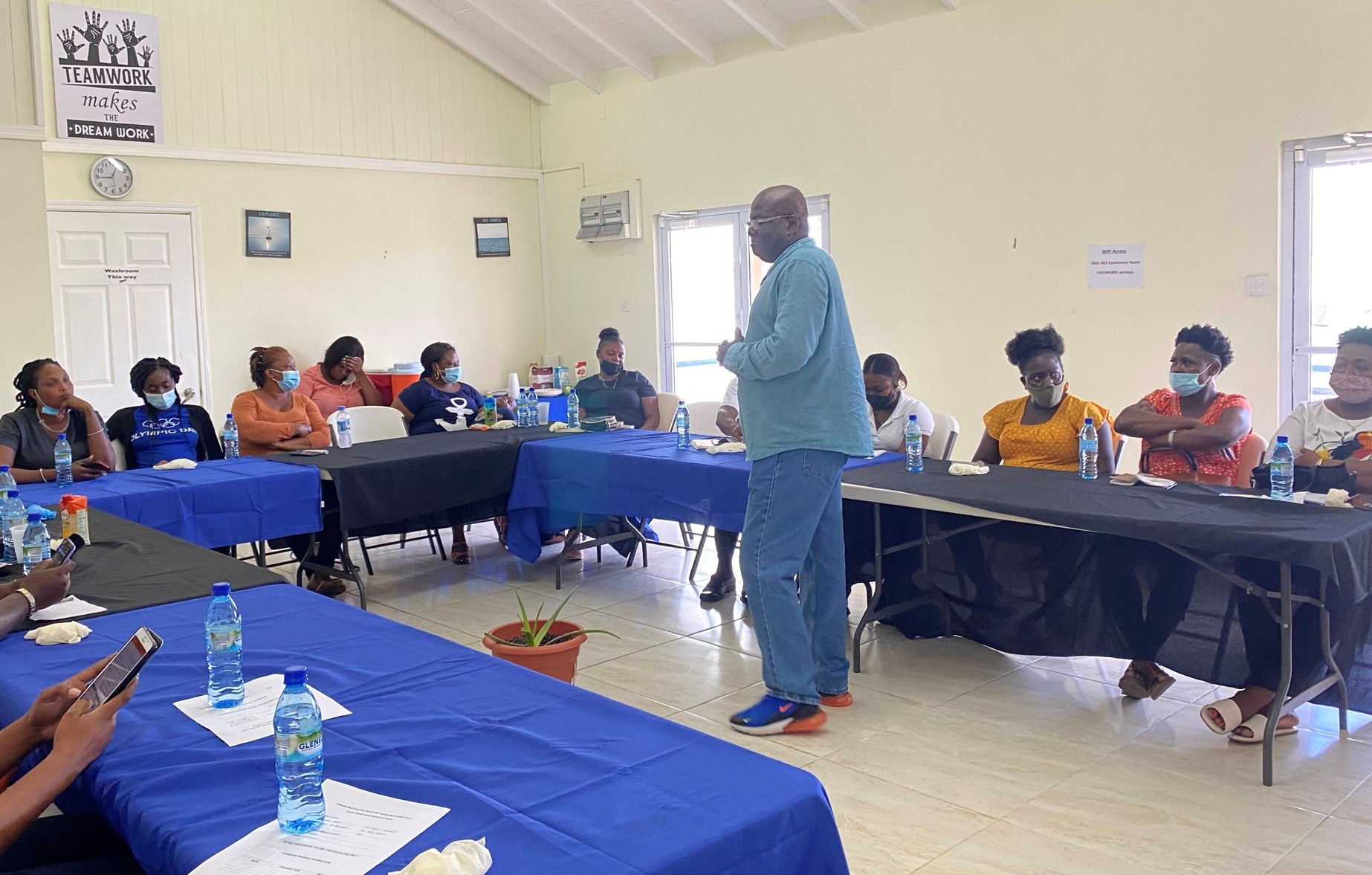
Newly certified First Aid practioners
Captive audiences also refer to first aid learners who have recently acquired their certification and use the app to help retain and exercise their new knowledge. Bystanders without any training could also be captive audiences in a moment of need, while looking for immediate solutions to either critical or non-critical first aid situations that they may encounter.
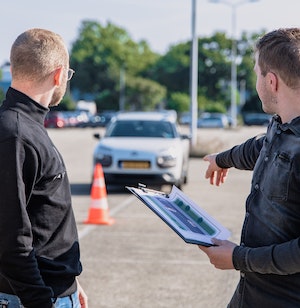
Professional certification
First Aid instructors, babysitters, lifeguards, professional, taxi and Uber drivers, gym staff (in Argentina and other countries), police officers, nurses, children's day camp staff, primary school teachers, and others are just some of the professionals who require First Aid certification. First aid certification is also a requirement to get a driver's license in Albania, and possibly other jurisdictions.
There are additional professional categories, like restaurant owners and AirBnB hosts that do not require First Aid training that could benefit from using the app as an introduction.
School-age children
Another app audience with the potential to be expanded is school-age students. We heard from stakeholders that in France, Albania and Nepal, for example, students are required to take First Aid courses. With this in mind, young people represent a tremendous opportunity group for app usage and First Aid course enrollment, but more of them need to know about these resources and have access to them.
Skepticism of app usefulness
Some groups are skeptical of the usefulness of an app, including many First Aid instructors who favor traditional tried-and-true, face-to-face teaching methods and materials as still the most effective. They may not be looking to digital resources to supplement these, or say that their utility is limited.
Design Recommendations
Instructor-focused campaign
Support the newly certified
Consider creating tools and resources specifically designed to reinforce what people have learned in Red Cross courses. These may take the form of encouraging reminders, virtual or asynchronous study, as well as digital networking opportunities that enable the sharing of information between app users.
Provide targeted content by occupation
Consider creating unique tabs and menus within the app for different professional groups to help direct them to the right resources (e.g. AirBnB hosts, infant First Aid resources for babysitters. etc.)
Underserved user groups
Marginalized communities
There are some key groups that due to geographic, technological, social, or educational barriers do not have access to first aid training through the Red Cross/Crescent. They may live in remote areas and not have contact with or be aware of local offices. In addition, senior citizens above 60 years old are less accustomed to using many apps, including the First Aid app.
“The app doesn’t currently have the ability to serve people with physical challenges [such as sight impairments].”
– Samantha Dickson, Grenada Red Cross
Providing universal accessibility
These issues exist in lower and higher income countries alike, and if not addressed in the new app's design, will limit expansion of the app’s user base to include marginalized groups.
The digital divide
There is significant potential for these groups to be served through digital solutions, through the app and otherwise. However, marginalized individuals of all ages frequently live in situations or communities with low internet connectivity and/or smartphone availability, or where their data plans cannot effectively support frequent app usage.
“In remote areas, there are some problems because of internet problems. Generally, people who don’t go to school or work in the countryside don’t have the opportunity to use the app.”
– Salomé Boucif, GFARC, Croix-Rouge française
“The current layout of the app is not intuitive for those who are less familiar with mobile learning. Users may feel overwhelmed by the amount of content or how it’s laid out.”
– Joanna Muise, Canadian Red Cross
Designing for marginalized groups will make the app better for everybody
By taking the needs and aspirations of marginalized users into account during the design process, the new Red Cross/Crescent First Aid app will likely engage a larger audience.
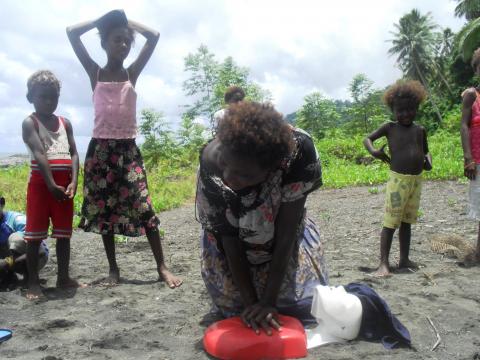
User needs and goals
Diverse expectations of the First Aid app
When it comes to expectations for the app, research participants articulated a variety of needs and preferences.
Some needs were precise, like access to more topic-specific information. For example, seasonal needs like treating heatstroke in the summer, frost bite in the winter; regional factors like treating poisonous animal bites or poisonous plants; weather preparedness and disaster preparedness; backcountry survival skills, and more.
Some needs were broader, like access to more videos and scenarios, more challenging quizzes, and more ways to actively and proactively engage with the app to become a better First Aid practitioner.
Contemporary use cases
In designing for specific and broad needs simultaneously, the development team should take into account use cases and scenarios that extend beyond those that have defined existing First Aid materials, and should incorporate contemporary ones that may be more representative of the real circumstances that app users find themselves in.
To hear a story about one respondent's experience needing First Aid while riding in a taxi in Uganda, click on the link above.
App usage changes depending on surroundings
The quantitative survey data (see diagram) also reveal that some people use the First Aid app in ways that are influenced by their immediate surroundings. For example, one Latin American respondent said they had used the app to help during an emergency as well as to prepare for future emergencies. Other participants voiced the same type of usage, but this was not the case across the board. With regional factors in mind, it is important to design a very flexible UX that can be easily adapted to ensure success around the world.
“I watch videos on the British version with my kids - it'd be great to have some videos [on the Australian version] too. [These] help them see what would happen, and thereby lower their apprehension [when giving First Aid], especially for Australian situations, [like] snake bites.”
– Survey respondent, Australia
The app is underutilized
Ultimately, in considering all of these needs, the overarching goal for most app users is feeling more confident when it comes to first aid knowledge, skills and preparedness for moments of need.
Interestingly, along with the approval of many existing app features expressed by many respondents (as well as suggestions for improvement), in situations where First Aid is required, people often describe taking courses of action that do not involve using the First Aid app.
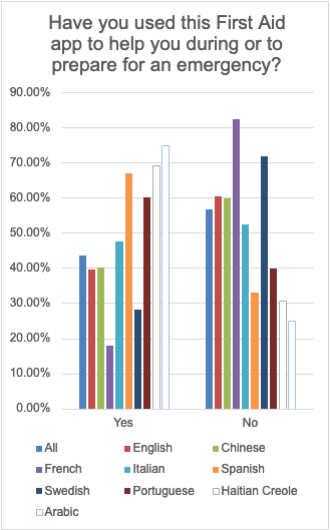
The chart above shows survey responses to the question, "Have you used this First Aid app to help you during or to prepare for an emergency?".
Personalization and regional relevance of First Aid topics
Our research indicates that there is variation in usage from one national society to another. While there are many that promote the app for training and retention, there are aspirations for the app to be used as a reference in emergency scenarios as well.
Design user flows that reflect modern First Aid realities
We recommend that the development team consider contemporary first aid scenarios that are more representative of the real circumstances that app users find themselves in, to create user flows that resonate more broadly.
Enable customization of topics of interest
Give app users the ability to prioritize topics that are most relevant in their lives, in addition to surfacing broadly trending topics. This will increase the level of engagement with the app.
Create a UX that works well offline in emergencies
Creating a native app is only one aspect of catering to the diverse needs of the app's potential user base. Consider offering customization options to users who would like to "bookmark" content that is relevant to them in a variety of scenarios that could arise locally and internationally.
How people use the app
There is a tension between what people say they downloaded the app for, and what they actually use it for.
Stakeholders and survey participants articulate that the app is designed primarily to reinforce knowledge and skills acquired during first aid training. However the most popular reason amongst survey respondents for downloading the app is to “have first aid information available in case of an emergency”.
"I just use this app to remind me of certain things, but a lot of information that I learned in First Aid is not necessarily in here."
– Survey respondent, Canada
This tension between what people say they want and what they actually do underlies the recommendation that the new app address a more expansive set of needs which include:
+ Providing access to emergency support (in the moment)
+ Empowering users to to validate what they have done
+ Using the app to reinforce skills and knowledge acquired during first aid training
+ Supporting preparation for situations in which First Aid is necessary
+ Providing opportunities to engage others
+ Fostering learning of new First Aid skills for users who have not taken a First Aid course.
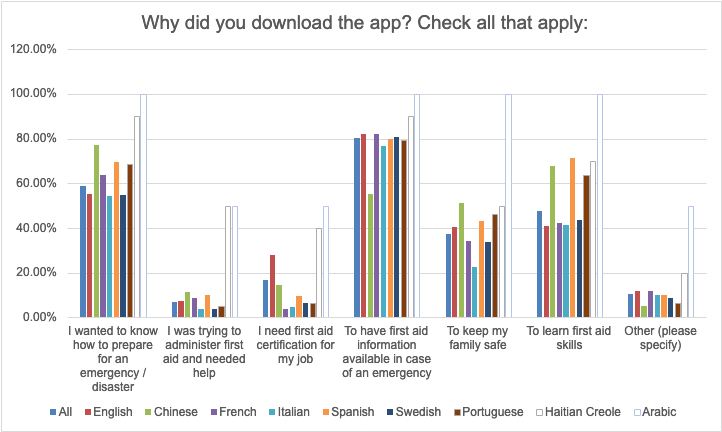
The chart above shows survey responses to the question, "Why did you download the [First Aid] app?".
“Bon pou mw menm mw se yn sekouris epi yn chofè anbilans Sèvis Leta mw itilize sèvis pwemye swen an preske chak lèm al travay."
It is good for me to be a rescuer and an ambulance driver for the State [ambulance] Service. I use the First Aid [app] almost every day.”
– Survey respondent, Haiti (translated from Haitian Creole to English using Google Translate)
Emergency support in the moment of need
Providing support during minor First Aid scenarios
Study respondents told us about using the app to help them navigate minor or less urgent incidents where First Aid was required. Common minor First Aid scenarios include: minor burns, cuts, stings, minor allergic reactions, and nose bleeds.
“[The last time that this app helped me protect myself or people I care about was when I accessed information on] minor injuries and [how] to control bleeding.”
– Survey respondent, Philippines
EMS contact information needs to be up-to-date and reliable
Very few people said that they expected the app to connect them to EMS in the event of an emergency. This is not to say that users don’t value this content but rather that if it is offered, the content and UX need to be robust and designed to cater to real world First Aid scenarios.
“I needed [the app] in an emergency situation but it wanted to do updates first and my internet was down. That's ridiculous and life- threatening. Every other app updates regularly.”
– Survey respondent, Australia
Providing support when every moment matters
Users also envision situations in which the app might help them navigate major incidents, where minutes matter. Common major first aid scenarios include: asthma attacks, snake bites, drownings, heart attacks, strokes, and other situations where CPR is required. Notably, treating snake bites was a common first aid scenario mentioned by study participants.
".”
– Raju Raut, Nepal Red Cross Society
Live chat and connections to telehealth providers
Consider including live chat or telehealth plug-ins for users in remote areas to use during emergencies i.e. TeleFA. This could be arranged in partnership with hospital systems and ambulance services that already offer similar services.
Linking app users to non-Red Cross/Crescent services
If the decision is made to connect users to EMS and other services via the app, we recommend making users aware very obviously that they are leaving the Red Cross app and being transferred to another service.
Reinforcing First Aid knowledge
Reinforcement provides app users with confidence
Reinforcing First Aid knowledge empowers users. Survey participants told us that they have used the app in a number of ways to reinforce what they learned during First Aid courses:
+ To study for a test - confirming and reinforcing what one knows and needs to know
+ To refresh one’s memory of skills one has already learned
+ To help retain knowledge
+ To validate what they have done.
“Six months after you take a First Aid course, you forget everything, so the app is critical for First Aid retention.”
– Salomé Boucif, GFARC, Croix-Rouge française
“After taking the First Aid course, I have used the app to refresh my memory about procedures so I would be ready for emergencies I was less confident about. I had one emergency with my 2-year-old getting a burn and we used the app to be sure we were doing the right things.”
– Survey respondent, Canada
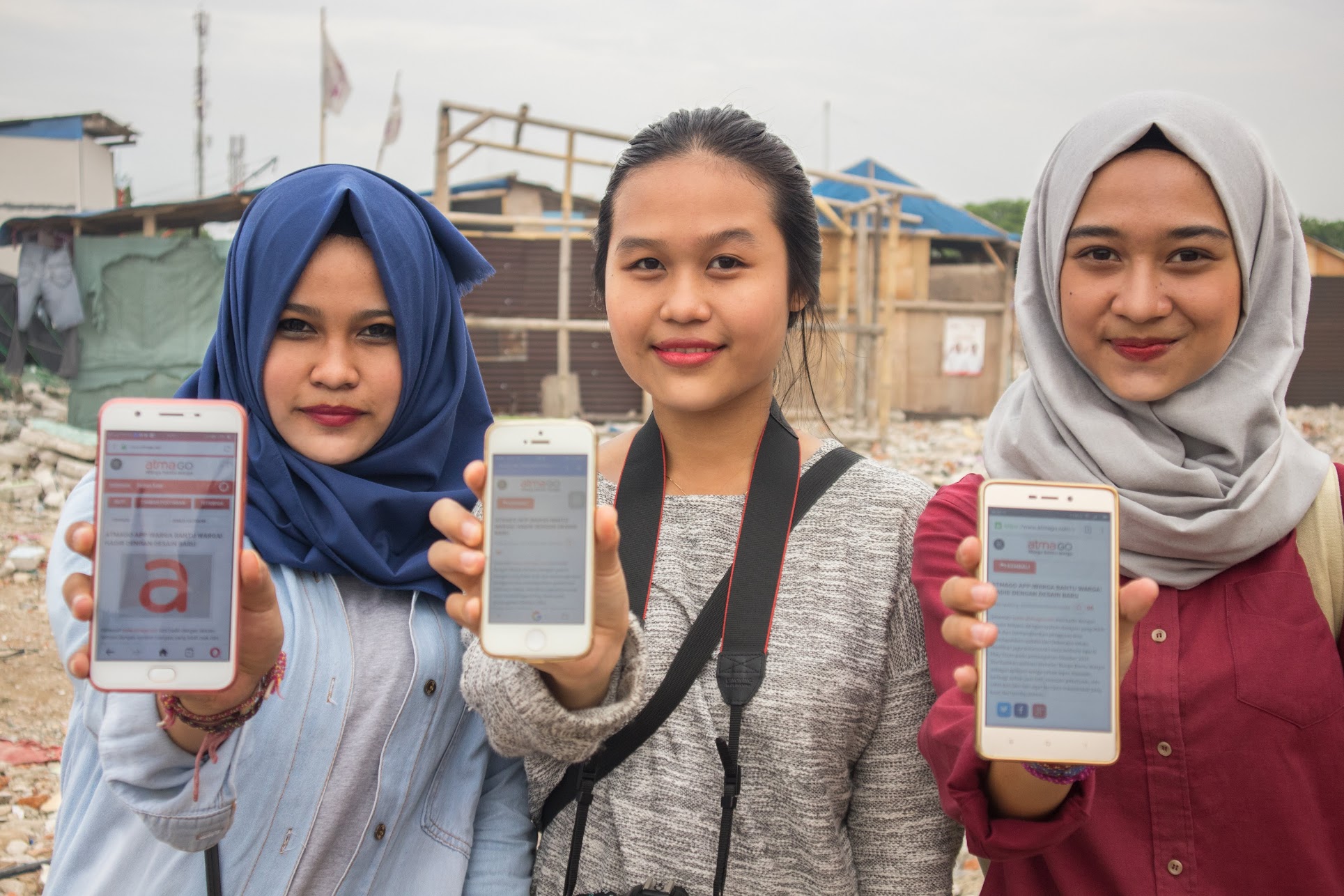
“One of my students had a nosebleed and I opened the app to double check I was doing the right thing.”
– Survey respondent Australia
Robust in-app search
In order to accommodate users who use the app to validate what they have done, consider making the in-app search function more robust and focused on this use case.
Triage quizzes and AR/VR experiences
Consider adding quizzes that strenghten app users' decision-making abilities in emergency situations. These triage quizzes could be enhanced by AR/VR modules designed to work with low-tech equipment like Google Cardboard.
Preparing for emergencies
Common preparation scenarios
Many participants described their usage patterns relative to specific scenarios and situations of need. They articulated that they want the app to help them practice and plan for a variety of First Aid scenarios. The more common scenarios that participants described were: disaster preparedness, personal injuries and care, taking on caregiver roles and trip planning.
Personal injuries and care
People want to know how to take care of themselves in case of injuries like sprains, breaks, stings, etc. In addition, post-op care recommendations, as well as recognizing and tracking symptoms like chest pains or a concussion, were mentioned by study participants.
Caregiver roles
People are regularly stepping into caregiver roles for family members without any medical or First Aid training. Some examples of this include: caring for someone when they come home from the hospital or after a surgery, and taking care of children, particularly for new parents.
“[I] Have prepared myself for what to do if my baby chokes."
"Har förberett mig för vad jag ska göra om min bebis kvävs."
- Survey respondent, Sweden
"[I have used the app to care for a relative] after surgery.”
– Survey respondent, Argentina
Disaster preparedness
People want to be able to access more resources and information relative to catastrophic weather and geological events like tornadoes, earthquakes, tsunamis, forest fires, etc. A number of survey respondents mentioned the use of an emergency backpack, in preparing for emergency situations like earthquakes.
“[I would like to see the following expanded content in the new version of the First Aid app:] Emergency backpack, how to deliver bad news, how to talk to upset family members, a simple review of anatomy, how to make a quick and specific medical questioning to the patient, what to do during an earthquake.
"Mochila de emergencia (que debe llevar), como dar una mala noticia, como hablar con familiares molestos, un repaso sencillo de anatomía, como hacerle un interrogatorio médico rápido y concreto al paciente, que hacer durante un sismo.”
– Survey respondent, Mexico
Trip planning
In situations where people are planning for a trip - especially to a remote area - they want to know what to bring along and how to put together an appropriate First Aid kit.
Module on preparing an emergency backpack
Consider adding a module on how to create an emergency backpack and / or First Aid kit for people who are preparing for a trip or an emergency scenario.
Design non-invasive notifications
Design non-invasive notifications that remind users that the app is on their device, and available for use when people are seeking First Aid information and guidance.
Engaging those not performing First Aid
Calming the victim
A number of survey respondents suggested including content in the app that would guide users on how to calm people that are being treated or assisted by a First Aid practitioner. Incorporating voice instructions that would enable someone using the app while administering First Aid, would enable them to better focus on offering reassurance. Adding this feature would also enhance the app’s accessibility by making it easier to use for people with limited sight.
Managing bystanders
Additionally, we heard from study participants that they would like to learn or be reminded about how best to engage bystanders when administering First Aid.
Create content designed to engage people other than the First Aid practitioner
Provide app users with tools and content that enable them to easily share information with others. For example, providing audio instructions that are read to people while they are administering First Aid and assist them in more easily engaging bystanders to help.
Create a community map
Consider adding an interactive community map (that functions like Waze) that enables app users to share locations of emergencies, accidents, disasters, hospitals, police and fire departments.
Providing a sense of security
The app helps users feel less alone in crisis situations
Having the First Aid app on their phones seems to provide some people with a sense of security after completing First Aid courses. At this time, students can get overwhelmed and the First Aid app provides them with a sense of assurance that they won’t forget what they have learned in the course.
“I have had to be first responder to a family member who died of a massive stroke. I actually think in that moment I would have used this app. [...] I really would have liked an audio voice to guide me [...] to simply feel less alone in the moment.”
– Survey respondent, Canada
Surges in app downloads during a crisis
This is further demonstrated by the fact that when there is a crisis event in a country, there is often a surge in app usage, demonstrating that people do expect to be able to use the app in the midst of an emergency situation and not only for the purpose of first aid preparedness.
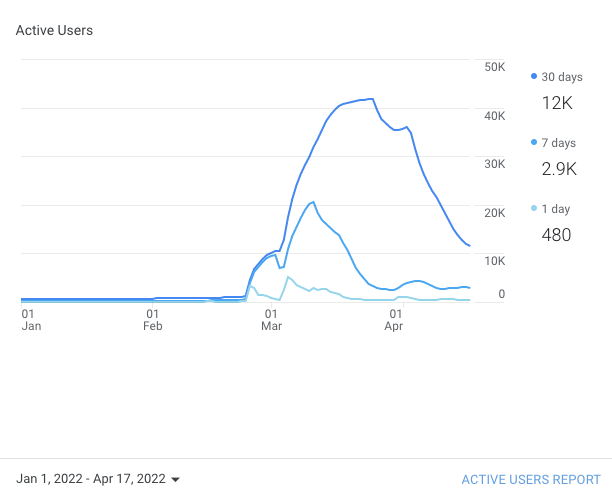
This chart shows the number of Ukrainian First Aid app active users, which surged on February 24, 2022, when the Russian invasion began.
Many app users forget they have it on their devices
Although it works well in this capacity, the app’s own analytics suggest that many people download the app on their phones and then forget that it is there.+ Focusing on this use case exclusively may alienate future users by not taking their needs into account.+ The security blanket functionality needs to stand alongside other use cases, without overshadowing them.
"People feel safe having it but don't use it every day."
– Stakeholder 7
"Je l'avais oubliée, avant de recevoir ce sondage."
-Survey respondent, Switzerland
"Olvidé que la tenía."
- Survey respondent, Mexico
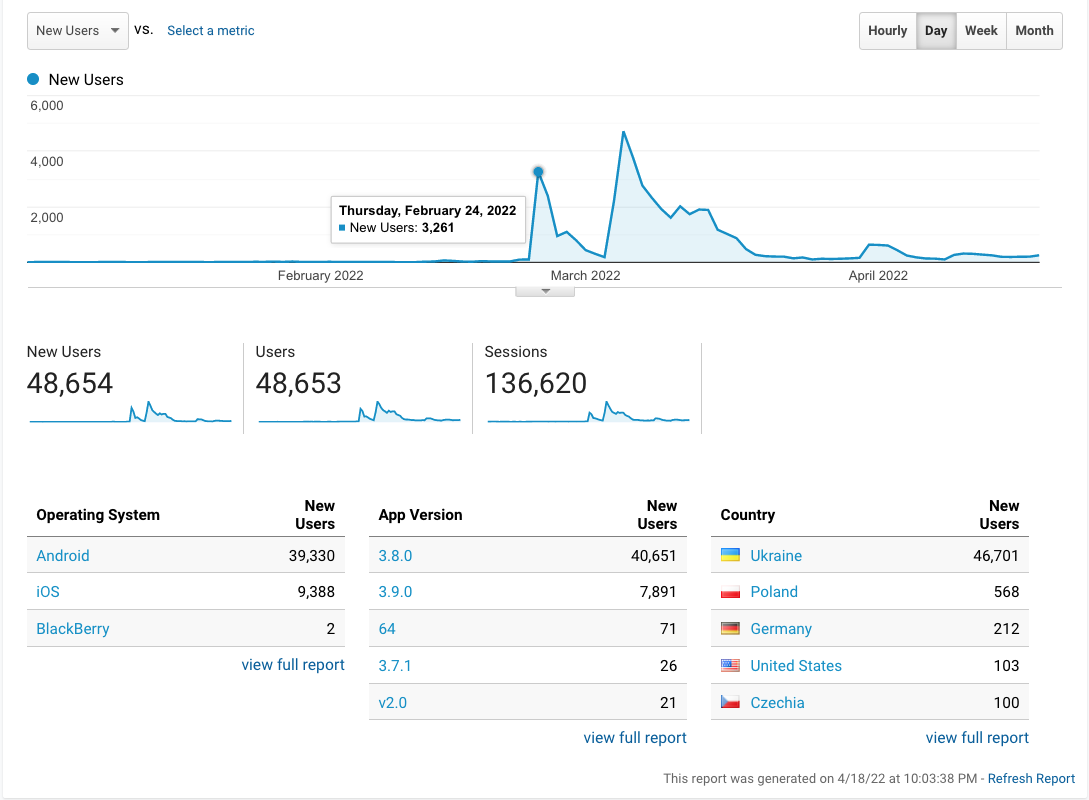
This chart shows the number of new Ukrainian First Aid app active users, which surged on February 24, 2022, when the Russian invasion began, and again on March 5, after Russia declared a partial ceasefire to allow humanitarian corridors in Ukraine. It is notable that the number of new Ukrainian app users is 220 times that of Germany's, whose population is nearly twice that of Ukraine's.
"Jag glömde bort appen."
- Survey respondent, Sweden
Esqueci que tinha o app."
- Survey respondent, Brazil
"I haven't needed it. I forgot about it."
– Survey respondent, Canada